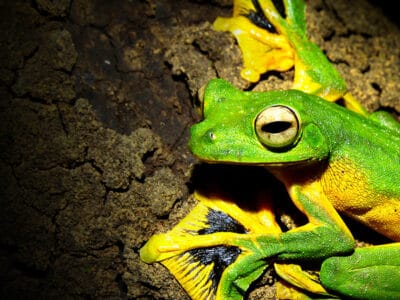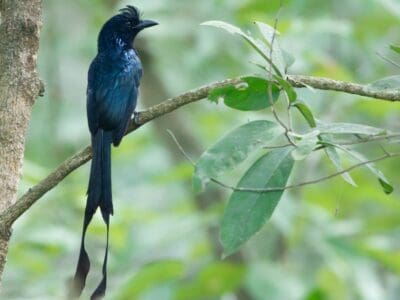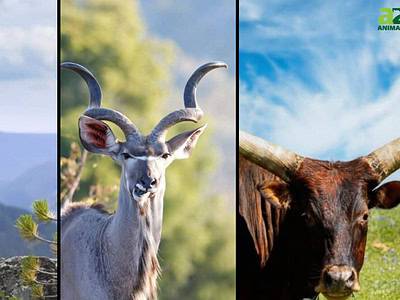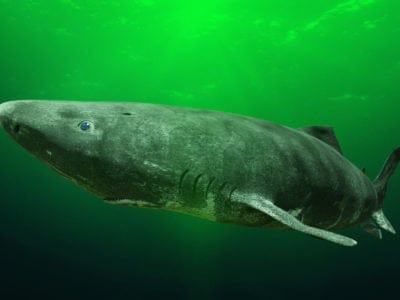Great Plains Rat Snake
Pantheropis emoryi
This snake vigorously shakes its tail as a way to frighten away predators.
Advertisement
Great Plains Rat Snake Scientific Classification
- Kingdom
- Animalia
- Phylum
- Chordata
- Class
- Reptilia
- Order
- Squamata
- Family
- Colubridae
- Genus
- Pantheropis
- Scientific Name
- Pantheropis emoryi
Read our Complete Guide to Classification of Animals.
Great Plains Rat Snake Conservation Status
Great Plains Rat Snake Facts
- Prey
- Rodents, birds, bats
- Group Behavior
- Solitary
- Fun Fact
- This snake vigorously shakes its tail as a way to frighten away predators.
- Litter Size
- 3 to 30 eggs
Great Plains Rat Snake Physical Characteristics
- Color
- Grey
- Dark Brown
- Skin Type
- Scales
- Length
- 2 to 5 feet
- Venomous
- No
- Aggression
- Low
View all of the Great Plains Rat Snake images!
“This snake vigorously shakes its tail as a way to frighten away predators”
Normally, the Great Plains rat snake is two to three feet in length. However, there are some that grow to a size of five feet! These snakes have a diet of rodents, birds, and bats. They live in a plains and grassland habitats as well as in rocky or brush-filled environments. Great Plains rat snakes are non-venomous with a timid nature.
3 Great Plains Rat Snake Amazing Facts!
- It coils up and shakes its tail in an effort to scare away threats
- A juvenile Great Plains rat snake looks almost identical to a juvenile black racer snake
- It constricts its rodent, bird, or bat prey
Where to Find Great Plains Rat Snakes
This snake lives in North America. In the United States, its range stretches from Missouri west to Nebraska, up to Colorado, and down into Texas. This snake is also found in the northern and central areas of Mexico.
It lives in a brush-filled, grassland, or plains habitat. Some are found on a rocky area of ground. They hide under sticks and debris or retreat into a burrow during the day. At night, Great Plains rat snakes come out to hunt. They’re very active during the mating season starting in late June.
Types of Rat Snake
The Great Plains rat snake is in the Colubridae family and in the Pantheropis genus. There are several other types of rat snakes living in North America.
Consider a few examples:
- Eastern rat snake (Pantherophis alleghaniensis)-It lives on the eastern coast of the United States from Florida running north through New York. They are longer than the Great Plains rat snake growing to a length of six feet.
- Baird’s rat snake (Pantherophis bairdi)-This snake occupies some of the same territories as the Great Plains rat snake. It lives in Texas as well as in northern and central Mexico. At four and a half feet long, this rat snake is larger in size than the Great Plains rat snake. Plus, this rat snake prefers a rocky habitat.
- Western rat snake (Pantherophis obsoletus)-The western rat snake shares some territory with the Great Plains rat snake. Its territory runs from Texas north to Minnesota. In terms of color, the western rat snake is all black whereas the Great Plains rat snake is a mixture of gray, tan, dark brown, and black.
Great Plains Rat Snake Scientific Name
Pantherophis emoryi is the Great Plains rat snake’s scientific name. The Greek word Pantherophis translates to panther snake referring to its ability to climb trees. The word emoryi refers to General William Emory, a U.S. surveyor who gathered a specimen of this snake in 1852. It’s also referred to as Emory’s rat snake or the chicken snake.
It is in the Colubridae family and class Reptilia.
Great Plains Rat Snake Population and Conservation Status
The population of the Great Plains rat snake is stable and consists of more than 100,000 adults. It has been placed in the area of Least Concern by the IUCN Red List of Threatened Species.
How to Identify Great Plains Rat Snake: Appearance and Description
This snake is tan or gray with large, dark brown blotches going down its back. All of its blotches are outlined in black. The snake has a spear-shaped brown marking on the top of its head along with a stripe near each eye. Its belly has a black and white pattern and there are stripes on the underside of its tail. It has round pupils. The snake grows to a length of two to three feet but can sometimes reach a length of five feet.
Though the prairie kingsnake is a different type of snake, it shares a similar scale pattern with a Great Plains rat snake. Furthermore, these two snakes live in a lot of the same areas, so it’s possible to mistake one for the other. Fortunately, they are both non-venomous!
A prairie kingsnake is tan or gray in color with dark brown blotches down its back. It also has a marking on the top of its head. But one difference between the two snakes is the blotches on the Great Plains rat snake are thicker and darker than the ones on a prairie kingsnake. Also, the black and white markings on the belly of a Great Plains rat snake are more defined and darker.
The juvenile Great Plains rat snake has a gray body with a pattern of dark splotches on it. It’s easily mistaken for a juvenile black racer snake because of its similar color and pattern. Juvenile black racers start out gray with dark splotches but change to all black as they approach adulthood.
How to identify a Great Plains rat snake:
- Tan or gray with dark brown splotches outlined in black
- A spear-shaped marking on its head
- A stripe across its head and near each eye
- Black and white patterned belly
- Stripes on the underside of its tail
- Round pupils
Great Plains Rat Snake Pictures
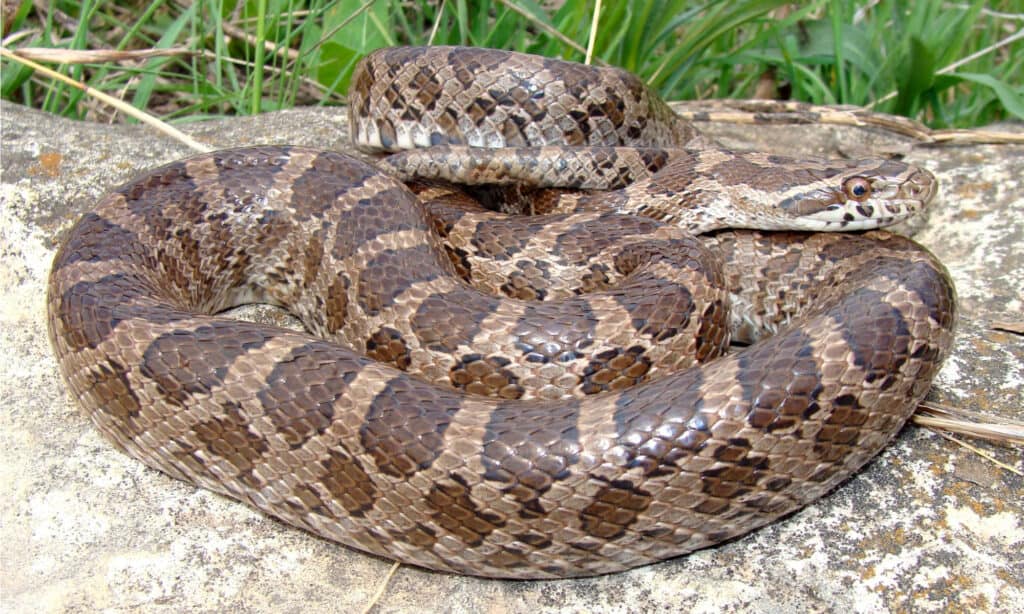
©Matt Jeppson/Shutterstock.com

©Dylan Wallace/Shutterstock.com

©Matt Jeppson/Shutterstock.com
Great Plains Rat Snake: How Dangerous Are They?
Great Plains rat snakes do not have venom. In addition, they have a timid nature and will try to escape a threatening situation.
Like other types of rat snakes, the Great Plains rat snake has the behavior of vigorously shaking its tail to scare away a predator or a human. Though a rat snake doesn’t have rattles on its tail like a rattlesnake, it can make a similar sound by shaking its tail in a pile of leaves.
A person who is bitten by a non-venomous snake definitely needs care in order for the wound to heal. So, most importantly, wash the injury with warm water and soap. Then, apply first-aid ointment to prevent infection. Next, cover the wound with a clean bandage. Check the wound every few days to ensure it’s healing. If there’s swelling and redness, then visit a doctor to get some further care for the wound.
Just remember: If you see a Great Plains rat snake coiled up and shaking its tail, it’s telling you to move away!
Great Plains Rat Snake Behavior and Humans
The rodents in the diet of this snake make it a familiar sight on farms and ranches in Texas, Colorado, and elsewhere in its region. It helps to keep the rodent population under control.
Unfortunately, the Great Plains rat snake is sometimes called the chicken snake. It has the false reputation of routinely going after chickens on farms. But this non-aggressive snake is mostly interested in capturing and eating rodents.
Similar Animals
View all 178 animals that start with GGreat Plains Rat Snake FAQs (Frequently Asked Questions)
Are Great Plains rat snakes venomous?
No, these snakes do not have venom.
How do Great Plains rat snakes hunt?
This snake hunts at night so it must rely on its sense of smell to track the chemical scents of rodents. These snakes have a reputation for being low energy, so they usually live in a place with lots of prey nearby. For instance, this snake may live near a cave where bats are hiding. When the snake finds its prey, it grabs hold of it with its jaws and wraps around the animal to stop its breathing. The snake swallows it whole.
Are Great Plains rat snakes aggressive?
No, these rat snakes are shy.
Where do Great Plains rat snakes live?
They live in the central and southern areas of the United States from Missouri to Nebraska and from Colorado down into Texas. It also makes its home in northern and central Mexico.
What do Great Plains rat snakes eat?
Their prey includes bats, rodents, and birds that are small in size. Sometimes they eat frogs, too.
Do Great Plains rat snakes bite?
Yes, they can bite. Remember, even a non-venomous bite needs proper care to heal.
How big do Great Plains rat snakes get?
The average length of this snake is two to three feet, but there have been some as long as five feet.
Where can I find a Great Plains rat snake?
These snakes are nocturnal, so they hide under brush and in burrows during the day. But at night, they’re moving in the trees or on the ground trying to pick up the scent of prey.
Thank you for reading! Have some feedback for us? Contact the AZ Animals editorial team.
Sources
- Illinois Department of Natural Resources / Accessed April 26, 2022
- Kansas State University / Accessed April 26, 2022
- Wikipedia / Accessed April 26, 2022
- UF Wildlife / Accessed April 26, 2022
- IUCN Redlist / Accessed April 26, 2022
- Wikipedia / Accessed April 26, 2022
- Lincoln Park Zoo / Accessed April 26, 2022









